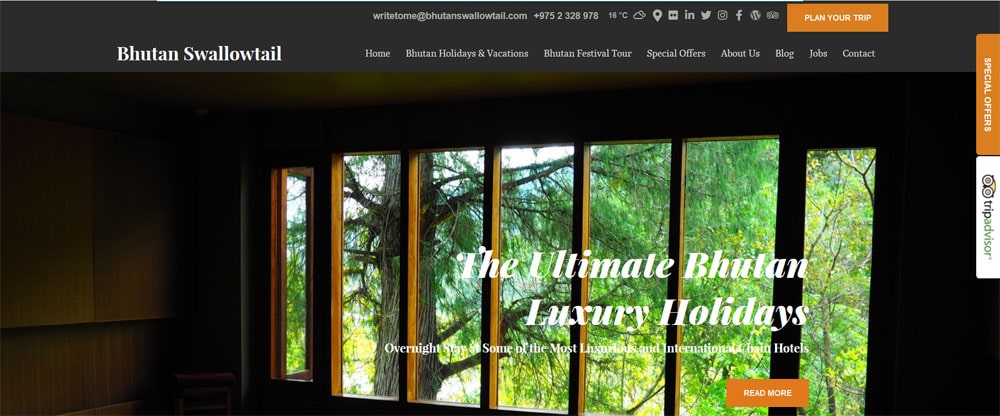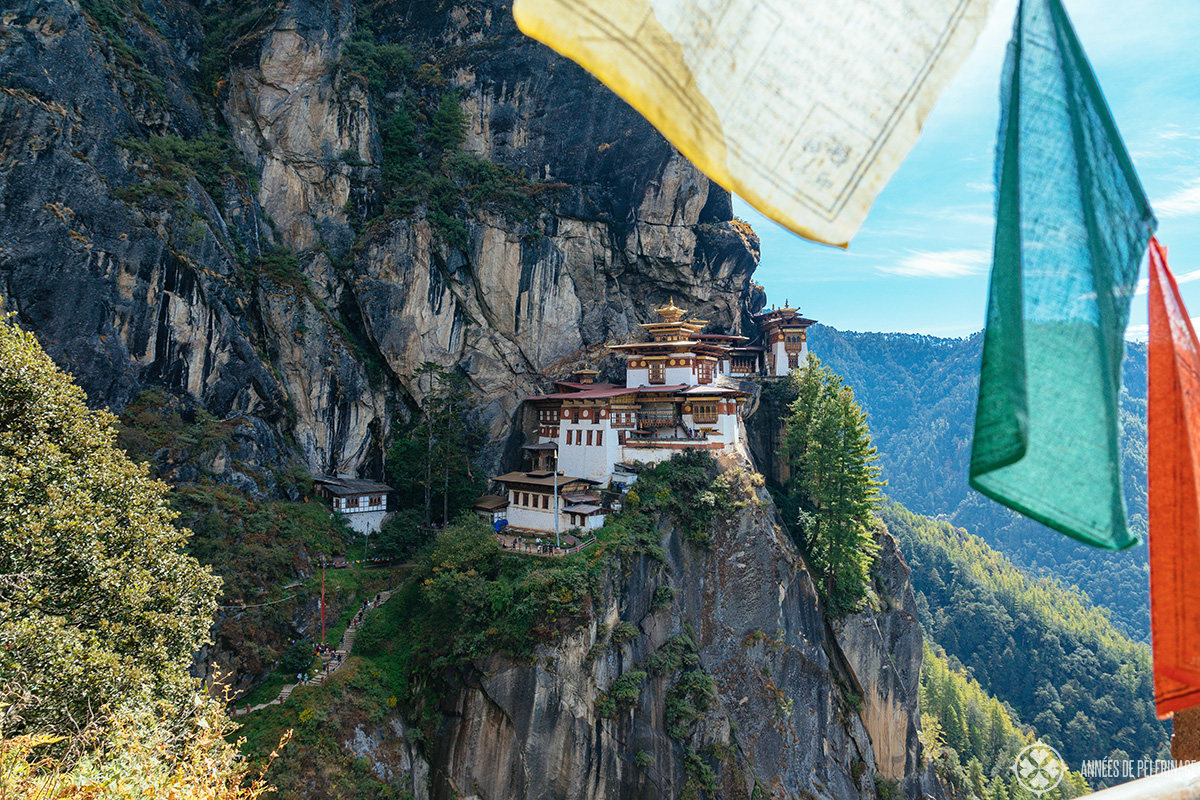
One of the happiest places on earth beckons. And I am planning to get there...once they open up the borders, that is
Dear Upper Tier Patreon supporters: this is the second of your poll stories, as requested. You wanted to read about how I plan a trip, and in this case to Bhutan, so here you are. Your comments are welcome, as always. You guys get it for 24-48 hours before it goes public. Please let me know if this is what you were hoping to get.
Get "there," of course, is relative. Here, it's a play on words. I am not going to Bhutan to get happy, I already am, which has taken a very long time. I am heading to Bhutan because it is a lovely place, deeply Buddhist. The Western values which can change it are already encroaching. So, in some ways, I hope to experience it before it has changed too much.
I am going to Bhutan. Likely this October, if not (right now the country is still closed to tourists), then next spring. May, precisely, for that is when the rhododendrons bloom. That part of the world is breathtaking in spring. October is festival month, and after the rains. Either way, I'm coming. Can't wait. Even in the pouring rain it's going to be gorgeous.
So how do I even choose my countries? First, I am drawn to horse cultures, such as Kazakhstan, Mongolia and many South American countries. Second, I prefer developing countries, for not only are they relatively less expensive (not Bhutan stay tuned) but that's where I am most comfortable. Third, I can stay longer, I learn more in less-Westernized cultures and am challenged far more deeply. When I talk to other travelers or read reviews, I seek out those people whose preferences align with mine. Those help me choose my next destination.
So, how come Bhutan?
My dear friend Melissa went to Bhutan a few years ago, and for her, it was indeed THE trip of a lifetime. It was a huge undertaking for her. She doesn't do adventure travel for a living, but for seven years she helped me train for and put my body back together when I came home from mine. As Melissa and I both have strong connections to Buddhism, for her, Bhutan was transformational. It's where she returns mentally when she needs a recharge.
So how do you even start planning?
- Find an operator.
Okay, look. I'm very fortunate in that I already am set up with a very competent organization. That makes this MUCH easier. Here's what to know: First, Bhutan can be very expensive. There is a per-day fee of $200 in low season, $250 in high season, and to get there from Kathmandu can be nearly as much as a flight to a distant nation from your town.
The good news is that those fees cover a great many things on your trip. This is not a nation which allows anyone and everyone to show up without some controls, which is how Bhutan stays Bhutan. The pricing makes it a more luxurious trip, but without the attendant "luxury" amenities. The luxury is simply being there and seeing this lovely country as it is. For some of us that's plenty enough. For me, it's the cost of two trips, but worth it.
My operator is Prem Khatry, who owns and runs Ace the Himalaya. In 2014, I booked Ace for the Everest Base Camp, and so got to know not his guiding company (the last time I checked there were nearly one thousand of them in Kathmandu, which makes choosing devilishly difficult). I went through www.theclymb.com, which does a fine job of identifying well-run and sustainable local, key word local, operators all over the world.
Prem's people did a bang-up job. Not only that, two other things: I signed up to do Annapurna in 2015. Turned out I was the only one who chose that particular trip. As we got close to the departure date, Prem wrote me and said, which just NOBODY does, that he would make sure I went up the mountain will a full crew even though I was solo.
That's service. However, nobody could have anticipated the earthquake, which devastated Nepal. Prem went right to work, making sure his people were taken care of first. Then in that way that good operators do, he flipped his trips for people wanting to do all his climbs into having them come for the same price and help rebuild the trails, the villages, his country.
That was smart. Because people DID come to do just that. That is why, when I saw that Ace was expanding into other regions nearby, I put Bhutan into my pipeline. The best way to get a good trip is to have a top operator. Finding one is ever the challenge, particularly if you're on a budget. So, budget operators can look very attractive, but budget operators come at a cost. More on that later.
2. Choose the type of trip you want.
Prem and I have stayed in touch over the years, so he has a good idea of what I can do and what I like. However, I don't like traveling in groups. When I'm doing stories, I tend to trip over other travelers. Most don't like the sports I want to do. So while being with other tourists is soothing for many, it's an annoyance for me. You decide if this needs to be educational, recreational, a pilgrimage as it was for Melissa, what Bhutan (or any country) is for you. That dictates what you tell your operator, or better guides what they can offer you.
I reached out to Prem and gave him the parameters: solo with guide, lose the bigger crowds, visit less-populated monasteries, wrap in some horseback riding. I also wanted a guide who can translate well. I wanted a general set of guidelines with lots of wiggle room.
I don't know much about Bhutan, and reading up on it is only marginally helpful as a complete outsider. It's hard for me to judge what I might or might not like. Rather than dictate to Prem what I want to see, instead I gave him the parameters of HOW I'd like to travel and the kinds of outcomes I want. When he sends me the itinerary, then I start picking and choosing as I begin researching those locations. He knows his countries, and so I lean into his knowledge. All he needs to know is whether I can handle the physical demands and the cultural requirements.
Here are some other options to consider, which include their Trip Advisor ratings. I have not used any of these, so can't speak to their quality:

3. Offer proof of what you can do.
Since Prem has never seen me ride, I forwarded him a YouTube video of my riding a lovely Egyptian mare at the gallop in Egypt, which says all he and any other operator needs to know about my riding chops. That is a VERY good method to get folks' attention. Too many people like to claim physical agency they don't possess, and providing a video is proof. That way it saves you from arguing with an operator who has had too many people misrepresent themselves. People, especially in a social media-saturated world, vastly overstate their physical prowess. That can really get you in trouble, as in genuine physical danger. Rather, understate and over-deliver, and boy will you be respected as a result.
4. Pick your time frame.
By this I mean time of year. I don't mind rain; I might mind monsoons. So our summer is out of the question. This article will give you solid guidance, and also explain why I am hoping to go this October:

In many countries, I do my level best to avoid high season, particularly when there are masses of tourists. The great Angkor Wat in the province of Siem Reap of Cambodia is overrun to the point of disaster. So you research in advance, find out what times of year and day that the crowds are the worst, and plan accordingly. Shoulder season is often best. While you may find yourself getting rained on or in the mud, quite often that's a small price to pay for quiet, better photos and fewer jostling and rude crowds.
5. Travel smart.
First, the flight.
When you travel this far, unless you plan a hotel overnight along the way to save your sanity, you will be exhausted for about two days. Plan for it. Rookie travelers assume that the day after they arrive they can leap to. No. You leap to, then fall flat on your face. Either punch in an overnight stay en route, or give yourself at least 24-48 hours to acclimate before you head out. That means a week becomes five days, which is simply not enough, when you're spending this much just to be there. Make your time count, save money, give this country the attention it deserves. Truth, that goes for all trips.
If you go through Germany, you can book a super handy short stay at the in-airport Napcabs. I love these things:

They rent for about $20 an hour, no toilet but near one as well as showers. Many airports have showers and lounges. This isn't a place to scrimp. That extra few hours' rest could save you a day or more of exploring, and that is priceless, at $250 a pop.
Second, pack lightly, as much as you can.
Since I ride, I'll be bringing my breeches and riding hat as well as boots that can do double duty and a pair of half chaps and riding gloves. Given that we are likely going to extend my stay into northern India, those locations might require certain clothing to transition from high country cold to pretty warm on the ground.
This isn't an article about how to pack, but a few things to keep in mind: bring clothing that you can wear a LOT without having to wash it. That means high-performance merino. And pieces that you can hand wash and which dry fast, and that means high-performance fabrics.
Most of us bring four times the clothing and barely a third the cash we need, so a good rule of thumb is to lay ALL your clothing out on the floor or bed and cut it by 75%. Be brutal, and keep only what will keep you covered, warm/cool. Layers rule, and these days the best layering can do triple duty.
You can now buy down coats with waterproof coatings, which are perfect for the Pacific Northwest where I live, and they are also perfect for places like Bhutan where it can be cold AND rainy.
Here is a piece which discusses what you might want to bring, along with some helpful suggestions (ALWAYS bring toilet paper, and something to read)

6. Have Plans B, C, and D.
Prem wrote me this week to say that even though he has already reached out to his people in Bhutan and put together an itinerary, which, by the way is about a third of what most cost not counting airfare, the borders are still closed. So like when we had planned a hike up Annapurna in 2015 and a massive earthquake sidelined that plan, you have to have backup plans. Climate change, unpredictables such as uprisings (why I can't go back to Kazakhstan for now), wars and the like are a fact of life in a fast-changing world. So you and I need to be willing to table our first preference trip and have other options already in mind.
If Bhutan doesn't pan out for October, there are many, many other options. I could ask Prem to organize a different trip or trips in the same regions, for example, or I could head to another country entirely. All our operators have to function in this kind of mode, for they have no control over governments or weather.

Finally, about trying to go cheap, as promised: Bhutan is simply not a budget location, because of the daily costs placed on tourists. You can find a broad range of operators, but the more you try to shave off the costs, the less you see and enjoy. That said, Ace's tours are half or less what I found elsewhere and he still consistently delivers top-quality experience.
As with all things, you get what you pay for. When it comes to international travel however, not all very high end tour operators deliver on the brand promise, just as trying to travel too cheaply can cost you in other essential ways such as safety and the quality of where you stay and what you get to eat. So be thorough with your research, read the reviews and plan accordingly.
***
Dear Walkabout Saga Reader:
If my work appeals to you, may I kindly invite you to consider joining those Patreon supporters whose generosity keeps the gas in my tank as it were. Those supporters get to dictate my content calendar, we engage as a community, and this website and its content acts in service to our collective best selves.
You can explore that option here.
However you decide to partake of my writing, thank you.


Comments powered by Talkyard.